 You may have seen some press coverage recently of the latest iteration of Cornell’s Macauley Library of Natural Sounds online. Today, Wired put together a fun little game in a slide show on their site, in which you can listen to clips of odd animals sounds, and try to guess whose voice you’re hearing. The accompanying article is a good introduction to the new Macauley archive, too. After reading the article, you can start playing the game by clicking “next” on the upper right corner of the animal picture grid on that page…
You may have seen some press coverage recently of the latest iteration of Cornell’s Macauley Library of Natural Sounds online. Today, Wired put together a fun little game in a slide show on their site, in which you can listen to clips of odd animals sounds, and try to guess whose voice you’re hearing. The accompanying article is a good introduction to the new Macauley archive, too. After reading the article, you can start playing the game by clicking “next” on the upper right corner of the animal picture grid on that page…
Falmouth turbine options group: no consensus, but impacts are recognized
Human impacts, News, Wind turbines Comments Off on Falmouth turbine options group: no consensus, but impacts are recognized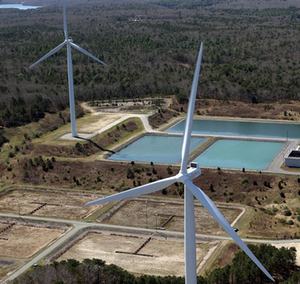 Even before meetings began, facilitators of the multi-stakeholder group convened in Falmouth to address widespread neighborhood complaints about noise from two town-owned turbines realized that the original goal of having group develop a consensus recommendation was too high a bar to aim for. So, the process was dubbed the “Wind Turbines Options Analysis Process,” with a hope of being able to present two or three options to the Selectmen for consideration before this spring’s Town Meeting.
Even before meetings began, facilitators of the multi-stakeholder group convened in Falmouth to address widespread neighborhood complaints about noise from two town-owned turbines realized that the original goal of having group develop a consensus recommendation was too high a bar to aim for. So, the process was dubbed the “Wind Turbines Options Analysis Process,” with a hope of being able to present two or three options to the Selectmen for consideration before this spring’s Town Meeting.
As it turns out, even that goal was elusive; in the end, the WTOP report summarizes four options, which generally reflect the initial stances of various stakeholder groups: take them down (the unwavering stance of the affected neighbors), run them at full power (the preference of the climate action groups in town and of those representing the town’s budgetary interests), or settle for one of two options involving shutting them down for all or part of the night (which satisfies neither the neighbors nor the climate or fiscal constituents). In all three of the options that will cost the town money (removing turbines and replacing a third to half of their capacity with solar panels, running them full-time and compensating neighbors, and shutting them down for 12 hours each night), the WTOP recommended that the town seek funding from the state to support the initiatives.
UPDATE, 1/30/13: The Falmouth Board of Selectmen voted tonight to recommend that the two town-owned turbines be dismantled, and for the town to ask the state for funding to help cover the town’s debt for the turbines, and for the MassCEC to forgive the town for Renewable Energy Credits previously purchased as part of the project financing. The Selectmen will prepare a warrant article for the April Town Meeting, likely to be followed by a town-wide vote in May.
A few things stood out for me as I read through the 55-page report and some of the supporting materials (available at this link).
First and most striking, even among those advocating operating the turbines at full capacity it appears that the reality of the impacts on neighbors is generally acknowledged. The report stresses that:
Although most of the discussion of acoustic measurement centered around whether, where, and how often the turbines exceeded DEP guidelines, most members of the WTOP acknowledged that operation within these guidelines would still not result in acceptance of the turbines by affected neighbors, since neighbors stated that compliance with the guidelines did not alleviate the health concerns they experienced.
In keeping with this understanding, the section of the report fleshing out the option of running the turbines at full capacity includes several measures meant to provide compensation for nearby neighbors; while brief, these options include purchasing (and reselling) homes, providing financial compensation that neighbors could use as they see fit (sound insulation or masking equipment, pay utility bills, etc.), and the possibility of the town offering a Property Value Guarantee.
A unique feature of the WTOP group was that it included two members whose charge, unlike all the other stakeholders, was to hold “multiple perspectives;” in essence, their task as individuals was to synthesize all the information, much as the group as a whole would ideally do. With the group unable to find a synthesis of its own, the conclusions of these members are especially valuable.
Cooperative Wisconsin turbine noise study breaks new ground
Health, Human impacts, News, Science, Wind turbines Comments Off on Cooperative Wisconsin turbine noise study breaks new groundIn December, four acoustic consulting firms collaborated to study wind turbine noise at three Brown County, Wisconsin homes that had been abandoned by their owners after the nearby Shirley Wind Project began operations. The study, organized by regional environmental group Clean Wisconsin and paid for by the state Public Regulatory Commission, will help inform the PRC’s consideration of a proposed new wind farm in the area.
Two things stand out about this new study. The first is the choice to bring together several acousticians who have previously been widely cited by opposite sides of the turbine siting debate. The study team included one firm (Hessler and Associates) commonly hired to do sound assessments for wind developers, another (Rand Acoustics) that has become widely championed by concerned citizens groups because of its much more cautionary assessment of turbine noise, and a third (Schomer and Associates) whose work has often been in the middle ground, with particular papers being seized on by each side in the siting debate; the fourth firm (Channel Islands Acoustics) has worked much less on wind farm issues than the other three. This diverse group of acousticians produced a 13-page consensus report (edited to 12 pages in the final version submitted to the PSC), along with an appendix report from each team, all of which focus on different aspects of the study that they found most compelling.
The second virtue of this study is that it clearly documented, for the first time, specific sources of infrasound (sound at frequencies below 20Hz) and low-frequency noise (audible sound above about 20Hz) from turbines that are consistently measurable inside homes. The data they collected clearly showed peaks in the sound spectrum that correspond to the “blade passing frequency” (BPF) of just under 1Hz, or one pulse per second, and several harmonics of the BPF up to about 5Hz. These pulses showed up both inside and outside the closest home, 1280 ft from the nearest turbine. In addition, they measured a more modest infrasound and low-frequency peak at 15-30Hz, which reflects the natural resonance and flexibility of typical home construction; this peak may have been triggered by turbine sound or by wind or other outdoor sound sources. One of the acousticians, Rand, notes in his appendix a possibly corresponding pulse of outdoor sound in the 9-14Hz range that can be associated with inflow turbulence hitting turbines. Still, the infrasound that was measured in this study, as in most other similar measurements of wind turbine noise, is at lower dB levels than what is typically considered perceptible by humans. (Ed. note: two emerging yet still limited bodies of work suggest that turbine infrasound may have rapid peaks that approach standard perceptual thresholds, and that our ears may respond physiologically to sounds at lower levels than are perceived; nothing in this Wisconsin study address these questions, though later analysis of the data may contribute to the study of short-term peaks.)
Since the study took place in homes that were abandoned by homeowners who all complained of debilitating health effects, including sleeplessness, nausea, and depression, part of the goal of the study was to see whether they could identify any possible acoustic triggers for these negative responses. The authors collectively noted that “the issue is complex and relatively new” and concluded that this work “was extremely helpful and a good start to uncover the cause of such severe adverse impact reported at this site.”
The consensus report, signed by all members of the team, introduces a new hypothesis, based on a US Navy study that found that vibrations can trigger nausea in pilots when in the frequency range of up to 0.5-0.9 Hz, with the peak “nauseogenicity” occurring at 0.2 Hz. Of particular concern is that as turbine blades get longer, the BPF is being reduced; only the recent generation of turbines has dropped below 1Hz (thus perhaps helping to explain the recent surge of health complaints among a subset of turbine neighbors), and planned larger blades will drop close to that 0.2Hz range of maximum inducement of nausea. While stressing that this is, as yet, a very preliminary supposition, especially since it involves a study based on physically vibrating the body, while turbine infrasound is a vibration of the air around a body, the authors still agreed that:
The four investigating firms are of the opinion that enough evidence and hypotheses have been given herein to classify LFN and infrasound as a serious issue, possibly affecting the future of the industry. It should be addressed beyond the present practice of showing that wind turbine levels are magnitudes below the threshold of hearing at low frequencies.
In particular, the research team agreed that a further literature search for studies related to vibration-induced nausea should take place (Paul Schomer is working on this), and that a “threshold of perception” test should be conducted, to see what proportion of residents are able to perceive the faint signals in either audible or infrasonic ranges. Only one of the five acousticians, Rand, could detect sound at all residences; he also reported headache and/or nausea (it is also noted that he is the only one among the five researchers who suffers from motion sickness).
As often happens, the reaction to this study ranged from “this changes everything” to “this is nothing new,” with some saying it proves negative effects and others that it proves wind energy is safe. For a run-down of the reactions, a brief look at each of the four appendices, and links to download the study, click on through…
Detailed new maps highlight excessive shipping noise in Puget Sound, BC coast
Bioacoustics, Effects of Noise on Wildlife, Ocean, Science, Shipping Comments Off on Detailed new maps highlight excessive shipping noise in Puget Sound, BC coast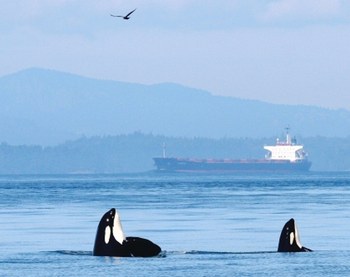 In the wake of NOAA’s large-scale ocean noise mapping project, two much more detailed studies from the Pacific Northwest have highlighted the likelihood that current shipping noise is already pushing the limits of what biologists think many ocean creatures can cope with.
In the wake of NOAA’s large-scale ocean noise mapping project, two much more detailed studies from the Pacific Northwest have highlighted the likelihood that current shipping noise is already pushing the limits of what biologists think many ocean creatures can cope with.
The first study recorded the sound from several types of boats and ships traversing Admiralty Inlet, between Whidbey Island and Port Townsend, WA, and used these recordings, correlated with ship traffic records, to model sound levels throughout the area. The Seattle Times summarizes this work, which found that at least one large vessel (container ship, ferry, or large tug) was in the area at least 90% of the time, and that the average noise level was about 120 decibels, which is the threshold above which federal agencies begin being concerned about behavioral impacts on some ocean species.
“Continuous noise at that level is considered harassment of marine mammals,” said University of Washington’s Christopher Bassett, one of the authors of the paper. “About 50 percent of the time, we even exceed that threshold.”
“It is concerning that the noise levels are so high,” said Marla Holt, a research biologist at Seattle’s Northwest Fisheries Science Center. “When you see how often this happens and how chronic the noise exposure is, that’s when you start to say, ‘Wow.'”
Interlude: Brief OrcaLab recording of threatened Northern Resident killer whales in Caamano Sound, BC, chatting with each other and then being drowned out by a cruise ship:
To the north, another study mapped shipping noise in the Salish Sea (south and east of Vancouver Island), and on up the British Columbia coast to the port of Prince Rupert. This work, funded by World Wildlife Fund-Canada, introduces a comprehensive approach to modeling sound transmission from ships, incorporating differences between vessel types, transmission loss in a variety of bathymetric and seabed conditions, and temperature-driven variations in sound speed during different seasons. (Download a PDF presentation summarizing the full WWF-Canada report here; a shorter version appeared in JASA in November). Here, too, large areas are subject to excessive shipping noise; the maps below show total sound levels, and the areas where the annual average of two specific low frequencies are above the 100dB threshold that the European Union considers the target for biologically sensitive areas:
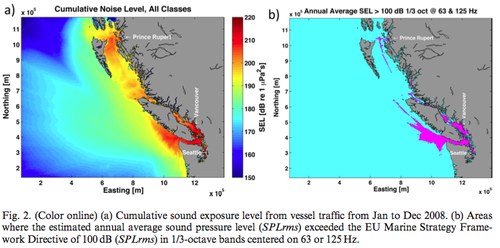
But now, check out that lighter colored patch about halfway between BC’s two big offshore islands.
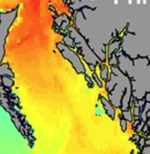 That’s an inland waterway that heads up to Kitimat, the proposed site of a major new port, the Northern Gateway, which would serve as the primary port for shipping tar sands oil to Asia. An annual total 220 super-tankers would head though that currently mostly-yellow zone, all the way up that long, narrow channel that points to the upper right hand corner of this close-up (and leave again—so more than one passage a day on average). As you might imagine, there is widespread concern about the risks of accidents and spills in these often treacherous passages, but the increase in shipping noise is also being raised as a question.
That’s an inland waterway that heads up to Kitimat, the proposed site of a major new port, the Northern Gateway, which would serve as the primary port for shipping tar sands oil to Asia. An annual total 220 super-tankers would head though that currently mostly-yellow zone, all the way up that long, narrow channel that points to the upper right hand corner of this close-up (and leave again—so more than one passage a day on average). As you might imagine, there is widespread concern about the risks of accidents and spills in these often treacherous passages, but the increase in shipping noise is also being raised as a question.
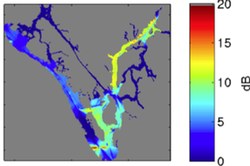 A second study by the same research team, led by Christine Erbe, took a close look at current and likely increases in shipping noise, should Northern Gateway go forward, and what they found is not reassuring. Noise levels will increase by up to 6dB in the approach lanes in Caamano Sound, and by 10-12dB in the narrow fjord into Kitimat (see map on right). In the western channel (the wider approach), where sound would likely increase 3-6dB (representing a doubling to quadrupling of sound energy), Humpbacks would hear tankers and their accompanying two tugboats for 43% of daylight hours, and orcas (due to thier higher-frequency hearing, less intruded upon by low-frequency ship noise) would hear the tankers 25% of the time. Fewer whales venture all the way up the fjords, but some would likely be present in the bend in the route, where noise levels would increase by 10dB, representing a 10-fold increase in sound energy.
A second study by the same research team, led by Christine Erbe, took a close look at current and likely increases in shipping noise, should Northern Gateway go forward, and what they found is not reassuring. Noise levels will increase by up to 6dB in the approach lanes in Caamano Sound, and by 10-12dB in the narrow fjord into Kitimat (see map on right). In the western channel (the wider approach), where sound would likely increase 3-6dB (representing a doubling to quadrupling of sound energy), Humpbacks would hear tankers and their accompanying two tugboats for 43% of daylight hours, and orcas (due to thier higher-frequency hearing, less intruded upon by low-frequency ship noise) would hear the tankers 25% of the time. Fewer whales venture all the way up the fjords, but some would likely be present in the bend in the route, where noise levels would increase by 10dB, representing a 10-fold increase in sound energy.
“There is a worry they will go away and not come back to these fiords,” says Erbe. “This is critical habitat, important to them. Are they going to be able to feed elsewhere? We can only answer that with long-term monitoring.”
These studies, one of which utilized four seasons of recordings, and the other presenting a comprehensive and verifiable sound modeling approach, both offer exciting steps forward in the study of coastal and oceanic acoustic habitats. Let’s hope that coming years produce many more studies from other regions around the world that continue to develop these innovative techniques.
Detailed Northern Gateway study: Erbe, C., Duncan, A., and Koessler, M. 2012. Modelling noise exposure statistics from current and projected shipping activity in northern British Columbia. Report submitted to WWF Canada by Curtin University, Australia.
BC sound modeling study: Erbe, C., MacGillivray, A., and Williams, R. 2012. Mapping Ocean Noise: Modelling Cumulative Acoustic Energy from Shipping in British Columbia to Inform Marine Spatial Planning. Report submitted to WWF Canada by Curtin University, Australia.
Shorter version: Erbe, C., MacGillivray, A., and Williams, R. 2012. Mapping cumulative noise from shipping to inform marine spatial planning. J. Acoust. Soc. Am. 132 (5), November 2012. 423-428.
Puget Sound study: Bassett, C., Polagye, B., Holt, M., Thomson, J. 2012. A vessel noise budget for Admiralty Inlet, Puget Sound, Washington (USA). J.Acoust.Soc.Am. 132(6), December 2012
Related:
Kathy Heise and Hussein Alidina. Ocean Noise in Canada’s Pacific Workshop, January 31-February 1, 2012. Summary Report. WWF-Canada. 54pp. Read or download PDF
WWF-Canada Submission to Enbridge Northern Gateway Joint Review Panel, 9/19/12. (mostly terrestrial impacts; some ocean noise sections) Read or download PDF
Perhaps we’re too distraught about the ways shipping noise affects whales, airplanes intrude on hikers’ solitude, or wind turbines disturb sleep of nearby neighbors. Wouldn’t it be nice to settle into the peacefully silent world of the International Space Station? Well, maybe not. Canadian astronaut Chris Hadfield has been following in the grand Canadian tradition of exploring the acoustic ecology of his home place, and the results are not at all like the stillness of the 2001 spaceship, nor the calm-broken-only-by-sudden-alien-encounters of the Starship Enterprise. Though he does highly recommend the Japanese Experiment Module as a place to get away from the cacophony that a CNET article calls “more like a noisy tin can.”
Here’s a taste of his recordings; see the CNET link above, or this Soundcloud page, for many more.
Quiet ocean experiment
Bioacoustics, Effects of Noise on Wildlife, Ocean, Shipping Comments Off on Quiet ocean experimentBoston’s WBUR recently interviewed Jesse Ausubel, of Rockefeller University and Woods Hole Oceanographic Institution, about an ambitious project dubbed the Quiet Ocean Experiment. The idea is to dedicate a year to making detailed observations of wildlife responses to temporary reductions in normally noisy ocean activities, and ideally, to spur a period of several hours to a day during which nearly all human activity in the oceans might cease, in order to see what effect that may have. Rather than studying the impacts of new noise sources, Ausubel and his colleagues hope to see what removing sound might do.
Here’s a link to a transcript of the five-minute interview. Or listen below:
New NOAA maps offer compelling picture of ocean noise
Bioacoustics, Ocean, Ocean energy, Science, Shipping, Sonar Comments Off on New NOAA maps offer compelling picture of ocean noise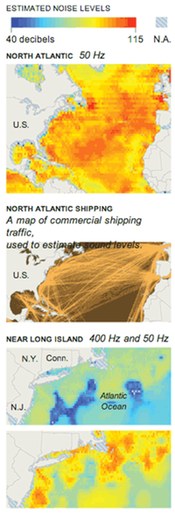 In December, NOAA announced the release of the first large-scale ocean noise maps, which have been in development for the past two years. The Underwater Sound Field Mapping Working Group modeled many sources of sound occurring within 200 miles of the US coast (including ships, seismic surveys, sonar, pile driving, and oil platform decommissioning), as well as modeling shipping noise in full ocean basins (including the Atlantic, pictured at left). Data is compiled in several depths and frequency ranges, to account for the full spectrum of various species’ habitat usage and hearing/vocalization ranges.
In December, NOAA announced the release of the first large-scale ocean noise maps, which have been in development for the past two years. The Underwater Sound Field Mapping Working Group modeled many sources of sound occurring within 200 miles of the US coast (including ships, seismic surveys, sonar, pile driving, and oil platform decommissioning), as well as modeling shipping noise in full ocean basins (including the Atlantic, pictured at left). Data is compiled in several depths and frequency ranges, to account for the full spectrum of various species’ habitat usage and hearing/vocalization ranges.
Dr. Leila Hatch, co-chair of the Working Group, said too many areas of the ocean surface (where sea mammals and whales spend most of their time) are orange in coloration, denoting high average levels. “It’s like downtown Manhattan during the day, only not taking into account the ambulances and the sirens,” she said. “I’d be happier saying it was like a national park.”
Michael Jasny, a senior policy analyst with the Natural Resources Defense Council, which has sued the Navy to reduce sounds that can harm marine mammals, praised the maps as “magnificent” and their depictions of sound pollution as “incredibly disturbing.”
“We’ve been blind to it,” Mr. Jasny said in an interview. “The maps are enabling scientists, regulators and the public to visualize the problem. Once you see the pictures, the serious risk that ocean noise poses to the very fabric of marine life becomes impossible to ignore.”
NOAA has set up a website where this ongoing work will be made available. In addition, an 85-page report brings together presentations and recommendations from a two-day symposium held last May, at which the Working Group presented their draft results to a couple hundred other experts from agencies, the Navy, oil and gas industry, academia, and nonprofit groups (I was fortunate to be invited to participate in that meeting).
Equally exciting is a companion project by a Cetacean Density and Distribution Mapping Working Group, also introduced at the May symposium, that is working to compile all known studies of whale and dolphin population distribution. Tens of thousands of cetacean observations are being compiled into month-by-month distribution charts and maps for various ocean regions around the US. In addition, seasonally biologically important areas (e.g., for breeding, feeding, or mating) are being compiled as part of this work.
The two mapping projects will provide a robust new foundation for assessing the impacts of noise sources, and hopefully to encourage efforts to reduce human noise, especially in biologically important areas. A New York Times article introducing the noise mapping project includes encouraging words from Michael Bahtiarian, an adviser to the United States delegation to the International Maritime Organization, which is looking at ways to reduce ship noise and vibrations. “Right now we’re talking about nonbinding guidelines,” he said “At a minimum, the goal is to stop the increases.” See earlier AEInews coverage of the IMO efforts from 2008, 2009, and 2012.
SEE ALSO: Detailed ocean noise maps take this approach further in Puget Sound, BC coastal waters
Massachusetts grapples with diverse responses to wind turbines
Human impacts, News, Wind turbines Comments Off on Massachusetts grapples with diverse responses to wind turbinesEastern Massachusetts continues to be a hotbed of both small-scale wind development and ongoing complaints in several towns. Sixteen communities in the area now host one to four wind turbines (not all of which are full-sized industrial turbines); in five of these towns, complaints have been relatively numerous (a dozen to several dozen individuals). Some of the turbines are owned by towns, generally to power a portion of town-owned facilities, and some are owned by businesses, for their own power, or by private wind developers.
The Boston Globe published a series of articles this week that offer a good picture of the range of responses and opinions at this point in time:
- The main article features the full spectrum of views, including comments from neighbors, town officials, green energy advocates, a lawyer, a sound consultant, and a dispute resolution specialist (a slightly different version, abridged but with a couple different neighbor quotes, is also available)
- Another article covers a recent lawsuit by a couple in Scituate who live just 640 feet from a turbine there
- And a third article features the generally positive attitudes toward three turbines in Gloucester
RELATED: Falmouth’s First Abandoned Turbine House, a letter to the editor from a former neighbor of one of the Falmouth turbines, who’s cashed out her retirement savings and moved to another town
33dB town noise limits spur request for state approval of NH wind project
Human impacts, News, Wind turbines Comments Off on 33dB town noise limits spur request for state approval of NH wind projectTimbertop Wind has asked the New Hampshire state Site Evaluation Committee (SEC) to assume jurisdiction over a proposed 5-turbine wind farm that straddles the town line between Temple and New Ipswich. The SEC always has jurisdiction over projects of 30MW or more; the Timbertop project is only 15MW, so the SEC will decide later this winter whether to get involved.
The request came in part due to some differences between the Temple and New Ipswich siting regulations, though the primary concern noted by by Adam Cohen of Timbertop is the noise limits imposed by 2012 ordinances passed in both towns, which set a maximum noise level of 33dB on non-participating neighbors’ property. “While the ordinance originally adopted in New Ipswich in 2010 was reasonable, the ordinances as adopted in New Ipswich and Temple in 2012 impose substantive requirements inconsistent with SEC precedent and state law,” Timbertop’s recent application to the SEC states.
In some other rural towns, noise complaints become more common as sound levels top 35dB, with sound levels of 40-45dB creating significant community annoyance. The 33dB limit appears to be an attempt to greatly minimize the chance of serious noise issues for any neighbors, though turbines may still be slightly audible on some nights; see this recent post on noise studies in Woodstock, Maine, with noise levels at about what would be allowed under this ordinance.
New Ipswich Planning Board Vice-Chair Liz Freeman said hat the board felt that it was the right level for a rural town like New Ipswich. “The Planning Board did not think it would be prohibitive and we did not think it was unreasonable,” she said. “It was based on recommendations from consultants with many years of experience on community noise issues.” The wind ordinances were adopted with large majorities in both towns; Ed Decker, a New Ipswich Planning Board member, stresses that “The will of the people of New Ipswich was made clear by their votes, and it’s inappropriate for the state to override the people of New Ipswich.”
See this detailed article in the Monadnock Ledger-Transcript for more.
